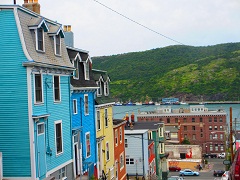Walking through this cozy city, it is easy to understand why Newfoundland is considered Canada's most colorful province. Wooden houses in all imaginable colors makes you feel like you are walking through a fairytale. On top of this, the city is beautifully located in a sheltered bay surrounded by bare cliffs.
In the small village of Quidi Vidi, just outside St. John's, we visited a micro brewery and got to try beer brewed with iceberg water. The beer might have been a bit pale but it was still an interesting experience.
Unfortunately the weather was not on our side the following day when we visited Canada's most eastern point at Cape Spear. Instead of hiking along the cliffs trying to spot whales, the rain made it an easy decision to head back into town to return our rental car.




















































